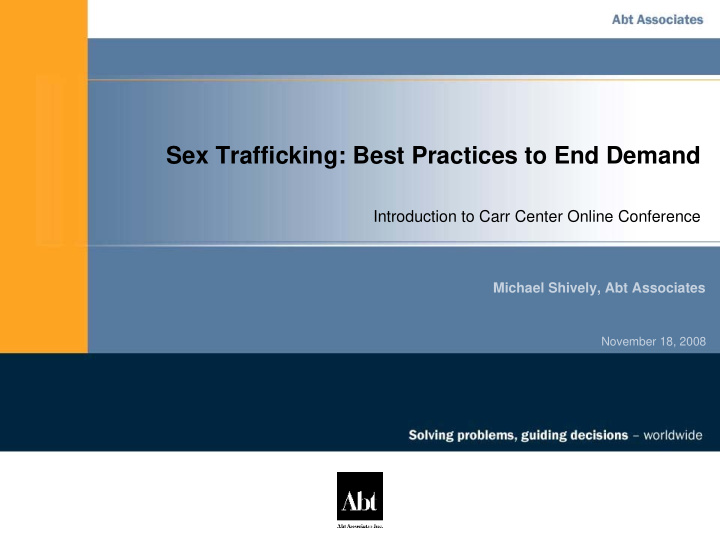



Sex Trafficking: Best Practices to End Demand Introduction to Carr Center Online Conference Michael Shively, Abt Associates November 18, 2008
Model of Prostitution & Sex Trafficking Market Traffickers, pimps Distribution Consumers of Commercial Providers of Commercial Sex Sex (“johns”) (prostitutes, victims of CSE) Supply Demand Source: Lederer, 2006
Demand: Men’s Motivations for Seeking Commercial Sex Needy/Lonely Men • Intimacy (“girlfriend experience”). • Emotional support that they do not receive elsewhere. • Difficulty meeting women conventionally. • Feeling that women find them unattractive. Emotionally Distant Men • Sex with little or no emotional involvement. • No time or desire for the responsibility of a conventional relationship. Thrill Seekers • Unusual sex acts that most women are unwilling to engage in. • Excited by the illicit nature of prostitution. • Sex with women with a variety of physical traits. Sociopaths/Misogynists • Less risky means of mimicking extreme or illegal fantasies, such as incest or rape. • Desire being “in control” or dominating women when having sex. • Harming/humiliating women. Sources: Bernstein, 2001; Farley, 2007; Hoigard & Finstad, 1992; Lau et al., 2004; Lever & Dolnick, 2000; Mansson, 2006, McKegany & Barnard, 1994; Monto, 2000; Winick, 1962; Xantidis & McCabe, 2000
U.S. Sites Pursuing Demand Reduction Strategies Number of Demand Reduction Strategy Sites Identified Law Enforcement Reverse stings (street operations)* 536 Reverse stings (Web-based) 100 Shaming: Names and/or photos publicized 300 Shaming: “Dear John” letters sent home 24 Auto seizure 73 Geographic restraining orders or zones 42 Community service 13 Surveillance cameras in active prostitution zones 5 12 Public Awareness/Education Campaigns 15 Neighborhood Programs Targeting Johns John Education or Treatment Programs * Evidence-based practice. John schools* (currently active) 43
Next Steps in Demand Reduction Research & Technical Assistance I. Leveraging what we already know • Training and technical assistance for practitioners. • Social marketing: inform public, like previous efforts against drunk driving, child abuse, date rape. • White papers aimed at policymakers. II. Learning more • Descriptive overviews of current “best practices.” • Evaluate the impact of each type of demand reduction approach. • Develop risk/needs assessment tools to screen arrested johns and route them to appropriate interventions.
Recommend
More recommend